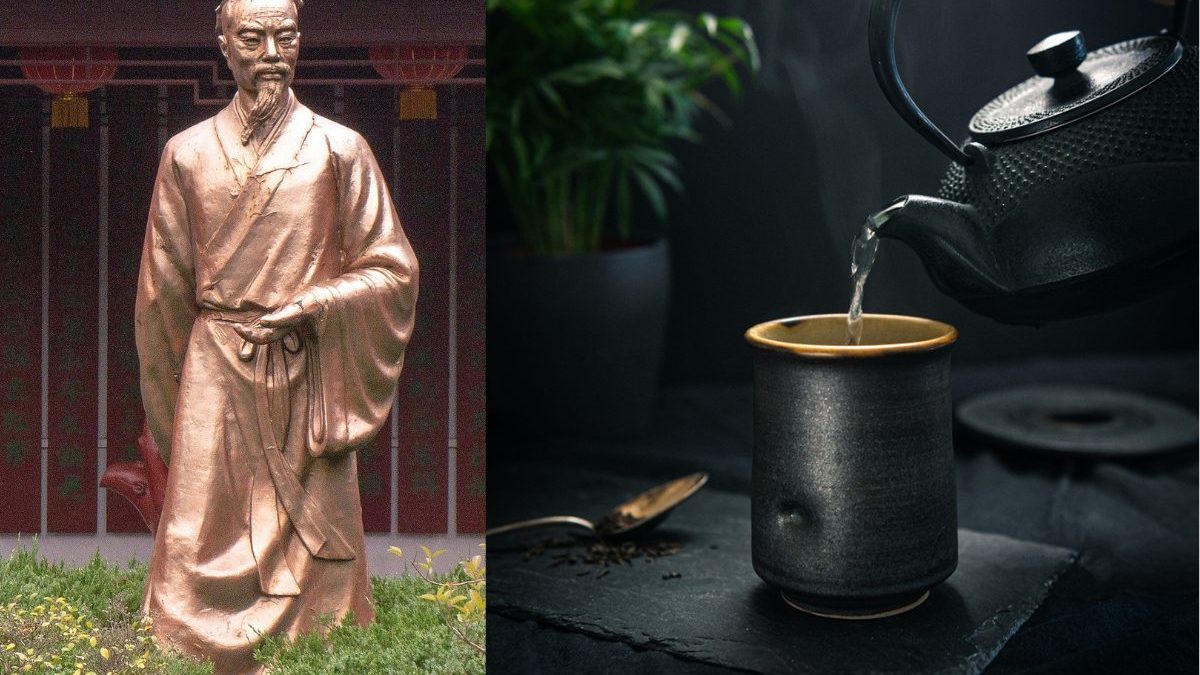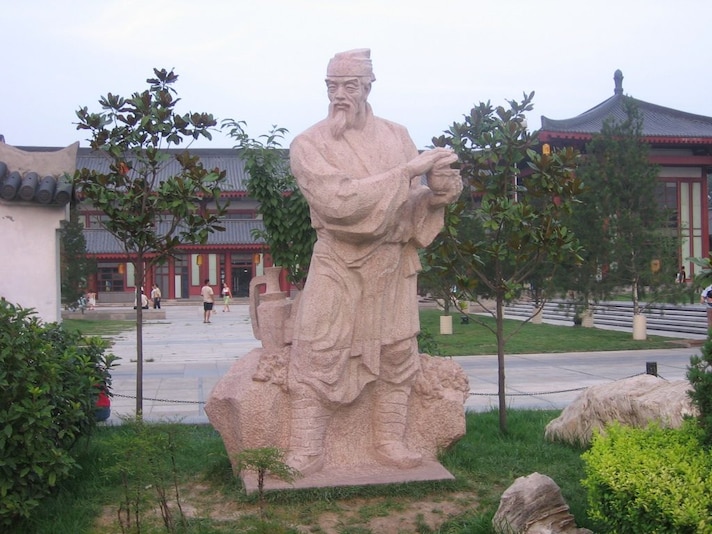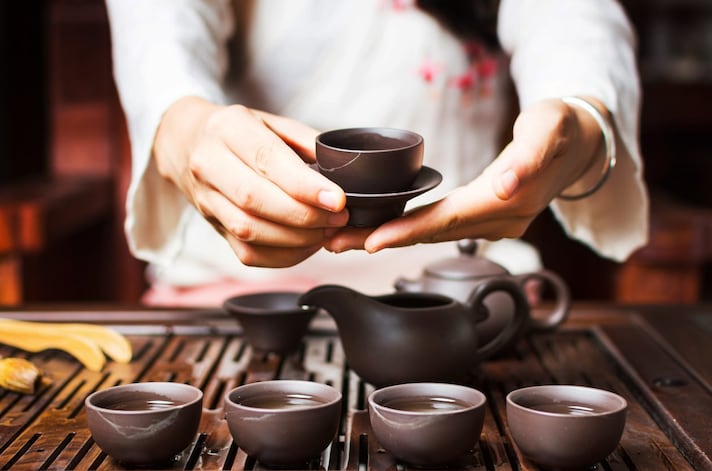
Today we are used to sipping a cup of tea – perhaps in front of the fireplace, covered by a blanket – but in reality this custom has not always been so common. The history of tea is very long but we have not always consumed it as we do today: tea was born as a medicine, in China, and then transformed into a savory soup with many different ingredients. A sort of "vegetable stock cube" containing a special flavor. In the same period it was also used as a currency of exchange, given in the form of ingots to the many merchants on the Silk Road or to travelers who arrived in the many states that populated China at the time. If today we drink tea and prepare it in a certain way we owe it to only one person, perhaps the first "influencer" ever: Lu Yu. This writer lived in the 18th century, was obsessed with tea and throughout his life spread the culture of its research and preparation throughout the world. Even today his " Chájīng ", translated as "Tea classic" is one of the most important and influential gastronomic books ever, a good 1300 years after its first draft. Let's see together how we went from "eating" tea, to drinking it.
We Drink Tea Thanks to a Medieval Influencer
It seems like a story from some book of oriental mythology but it is all true: Lu Yu was born in 733 in Tianmen, in Hubei and as a teenager his parents sent him to the mountain of Huomen to study the art of writing with Zou Fuzi, a sort of Umberto Eco of the Chinese Middle Ages. Among the tasks of the little Lu was that of preparing tea for his teacher. We have already gone beyond traditional medicine: in the 18th century China was aware of the beneficial properties of this infusion but used it more in cooking.
Lu decides to prepare a decoction, but the soup is inedible. He does not complain about the taste of the tea but about all the other ingredients: the soups contain shallots, ginger, jujube dates, citrus fruits, mint and other ingredients added to the noodles. The result of this long cooking is a very thick soup, sometimes almost creamy, with all these ingredients inside. It seems difficult to disagree with Lu Yu, it does not seem very inviting. The point is that the young Chinese man likes tea on its own and prepares it by grinding the leaves into powder and infusing them in very clear spring water, which he then heats up.

This way of drinking tea annoys all the inhabitants of the area: in Houmen they have been eating tea for thousands of years and, according to the famous historian George Van Driem, the populations of the area were the first to discover the energizing properties of the leaves, eating them raw. We do not know, however, when the Chinese switched from using these leaves as a snack to dipping them in a salty soup to flavor the water. What is certain is that this preparation arrives after the 2nd century AD because the Chinese eat tea only after having annexed part of the eastern Himalayas, once a no man's land and disputed with Burma. In a very short time they learned most of the secrets of these plants and in the medical treatises of Hua Tuo, a very famous doctor of the time, many properties are already described that we still appreciate in tea leaves today. For a couple of centuries in China, tea was used only for medicinal purposes until the flavor took hold: they began to boil the fresh leaves to keep them in pots full of rice and create a sort of pudding ante litteram. This porridge became very popular in the summer because it was able to dissipate the heat. Zhang Yi, a third-century scholar, also described a vegetable soup with added tea typical of the Chinese coastal areas used to cool off.

If you are wondering why today no one (or almost no one) in China proposes something like this, despite having a cuisine that has remained unchanged over time, the credit goes to Lu Yu. For the writer, soups "muddy the tea with other ingredients" and these soups are "just like chewing boiled vegetables", not exactly the best. In addition to the flavor, there is the whole mystical component: according to the historian James Benn, Lu actually wants to drink pure tea also because he considers it an elixir whose properties are dampened by banal ingredients such as garlic or rice and it is for this reason that he fought for so long to have tea consumed only with water and a pinch of salt, depending on the properties of the water.
Lu Yu then wrote a book to convince the Chinese to abandon the extra ingredients, explaining and guaranteeing the result of a drink enjoyed in purity. He emphasized the importance of obtaining spring water and fine tea powder, using high-quality tools such as stoves to heat the drink; he mechanized procedures, such as beating the powder to produce a little foam. In the book he compared it to the best-selling drinks of the time, declaring tea as the "official rival" of those proposed. No one thought that the change in that reality would have been successful, but upon its release it immediately became a best seller and this was no small achievement: there were not that many educated Chinese people, able to read, but everyone was talking about this book. In 763 the "tea-mania" began in China, making Lu Yu earn a fortune and creating countless imitators. In the space of half a century all the existing preconceptions were swept away: the mark that Lu left on Chinese culture was very evident right from the start. Even the local craftsmanship changes: all the ceramists of the time begin to create cups dedicated to him, they even make ceramic statuettes as is done today with the shepherds of San Gregorio Armeno and build statues in his honor in many places. Lu Yu is venerated, they call him "the God of tea".
You may be wondering how he managed to achieve all this success given that few people at the time knew how to read: Lu Yu was born very poor but from an early age he had a cheeky face and a propensity for self-promotion. He went from village to village as a clown, inventing funny shows until, at 14, he met a local governor who "adopted" the boy and convinced the family to send him to the mountains to study. In his book, his best friends included powerful officials, Buddhist and Taoist theologians, calligraphers and important poets, who obviously bought and spread his work in turn. A real network built with talent, dedication, courage and a small dose of luck. Thanks to his influence on these people, his character and also his light-hearted way of writing, a product of his previous circus career, he won everyone's hearts and changed the way people drink tea. Lu's influence on the Chinese ruling class is such that all the nobility categorically refuse soups and porridges containing caffeine forever. Su Che, a famous Chinese official, even in the 11th century (250 years after the author's death) destroys all the spicy concoctions offered by the court chefs because "Lu Yu orders it in the book".
The author's influence did not stop in China: even in Japan, despite the wars between the two nations, Buddhist religious people imported tea seeds and Lu Yu's famous treatise. Just think that Samuel Pepys, a sort of British Marco Polo, stopped right in the Land of the Rising Sun in 1660 and already considered this drink as Chinese precisely because the Japanese told him so, discriminating against anyone who did not drink tea in the way praised by Lu Yu.
Tea is Still Eaten and There Are People Who Drank It Even Before
Lu Yu's great strength lies in having been able to spread a culture that was previously only local and in having elevated a simple food to a true liturgy. He was not the first to drink tea in infusion, with boiled and pure water (this last is an element that we take for granted but that in the Middle Ages was not at all). Especially in Buddhist monasteries, monks use tea during meditation and fasting sessions. According to some scholars, the author himself would have taken this habit from a Buddhist monk he met in childhood and that perhaps this monk would have spoken to him about the "magical" power of the drink. In China, tea has been drunk for hundreds of centuries but only since 700 AD has this rite been "officialized" and delivered to the general public.
On the other side of the fence, there are those who still eat tea today: the inhabitants of the eastern Himalayas continue, after millennia, to eat these leaves, just like the ancestors of the Palaung tribes did. Even the extraction method has been the same for millennia: they steam and wrap the tea in banana leaves, then deposit these bundles in pits dug in the ground and collect the result after months of fermentation to use in lahpet thoke, a famous Burmese salad. The Jino tribe who live on the border between China, Burma and Laos also eat this product but do it in brine and use the fresh leaves to flavor stir-fried vegetables.
;Resize,width=767;)
